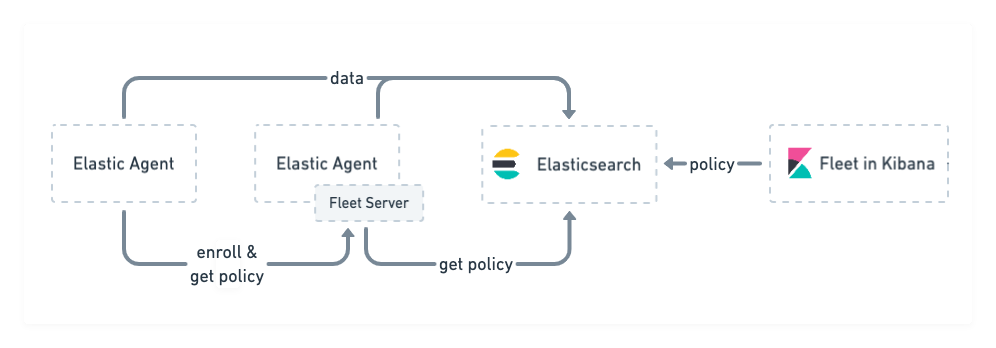Set up Fleet Server
editSet up Fleet Server
editFleet Server is required if you plan to use Fleet for central management.
- For self-managed deployments, you must install and host Fleet Server yourself.
- No extra setup is required on Elastic Cloud unless you want to scale your deployment. Elastic Cloud runs a hosted version of Integrations Server that includes Fleet Server.
What is Fleet Server?
editFleet Server is a component that connects Elastic Agents to Fleet. It supports many Elastic Agent connections and serves as a control plane for updating agent policies, collecting status information, and coordinating actions across Elastic Agents. It also provides a scalable architecture. As the size of your agent deployment grows, you can deploy additional Fleet Servers to manage the increased workload.
The following diagram shows how Elastic Agents communicate with Fleet Server to retrieve agent policies:

- When a new agent policy is created, the Fleet UI saves the policy to a Fleet index in Elasticsearch.
- To enroll in the policy, Elastic Agents send a request to Fleet Server, using the enrollment key generated for authentication.
- Fleet Server monitors Fleet indices, picks up the new agent policy from Elasticsearch, then ships the policy to all Elastic Agents enrolled in that policy. Fleet Server may also write updated policies to the Fleet index to manage coordination between agents.
- Elastic Agent uses configuration information in the policy to collect and send data to Elasticsearch.
- Elastic Agent checks in with Fleet Server for updates, maintaining an open connection.
- When a policy is updated, Fleet Server retrieves the updated policy from Elasticsearch and sends it to the connected Elastic Agents.
- To communicate with Fleet about the status of Elastic Agents and the policy rollout, Fleet Server writes updates to Fleet indices.
Service account
editFleet Server uses a service token to communicate with Elasticsearch, which contains
a fleet-server service account. Each Fleet Server can use its own service
token, and you can share it across multiple servers (not recommended). The
advantage of using a separate token for each server is that you can invalidate
each one separately.
You can create a service token by either using the Fleet UI or the Elasticsearch API. For more information, refer to Add a Fleet Server.
Fleet Server High-availability operations
editFleet Server is stateless. Connections to the Fleet Server therefore can be load balanced as long as the Fleet Server has capacity to accept more connections. Load balancing is done on a round-robin basis.
How you handle high-availability, fault-tolerance, and lifecycle management of Fleet Server depends on the deployment model you use. To compare deployment models, see Add a Fleet Server.
Learn more
editTo learn more about adding and scaling Fleet Server, refer to: